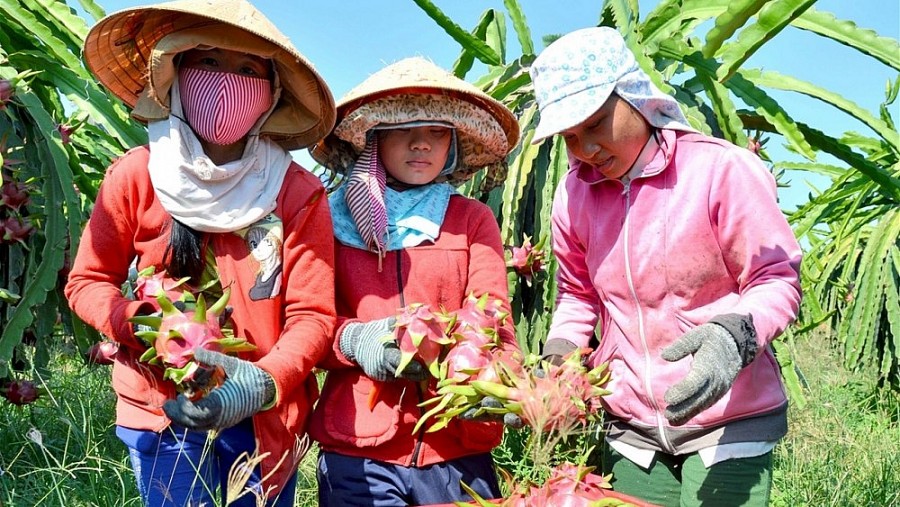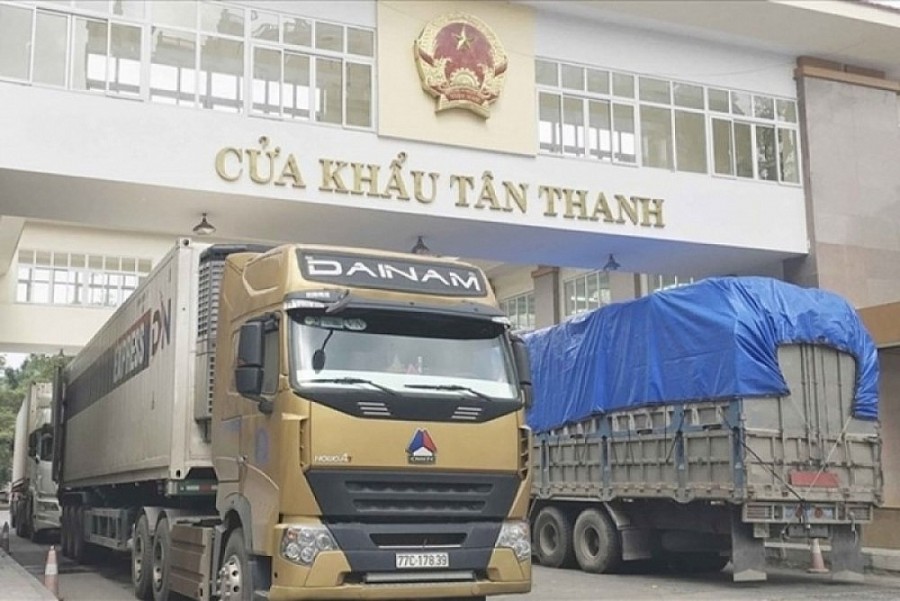 News
News
According to the Ministry of Industry and Trade , implementing commitments in the ASEAN-China Free Trade Agreement, up to now, China has reduced taxes on more than 8,000 items imported from Vietnam, including agricultural products, fresh fruits, and vegetables. opening up many opportunities for Vietnamese businesses to access this large market.
According to the General Statistics Office, the export turnover of goods in October 2022 was estimated at 30.27 billion USD, up 1.5% over the previous month and up 4.5% over the same period last year. In the first 10 months of 2022, export turnover of goods is estimated at 312.82 billion USD, up 15.9% over the same period last year.
 |
| Dragon fruit is an item licensed by China to be officially exported to this market |
China is the second largest export market and an important export market for some agricultural products of Vietnam (the largest export market for vegetables, fruits, cassava and cassava products). , rubber; the third largest export market for aquatic products, after the US and Japan).
Some groups of products such as seafood, fruit, and coffee of Vietnam are in the top 10 largest exporters to China, many items such as pangasius, basa, squid, dragon fruit, and fruit. lychee, cashew nuts all account for almost absolute market share in terms of volume as well as import turnover. That shows that many products and industries of Vietnam have strengths when participating in exporting to the Chinese market.
Currently, Vietnamese authorities are promoting negotiations with the Chinese side to open up the market for many of Vietnam's strong products, thereby creating more favorable conditions for goods, especially agricultural and aquatic products. Vietnamese products penetrate this market of more than 1.4 billion people.
Generally, in the first 10 months of 2022, the country's import turnover of goods is estimated at 303.42 billion USD, up 12.2% over the same period last year. China is Vietnam's largest import market with an estimated turnover of 100.7 billion USD.
Vietnam imports from China a lot of raw materials for production, besides vegetables, food, consumer goods... With a close geographical position, the source of raw materials is imported from China. has strong competitiveness, contributing positively to the growth of Vietnamese exports.
The Ministry of Industry and Trade strives to increase trade between the two countries
Over the past time, as a state management unit on import and export, the Ministry of Industry and Trade has implemented many solutions to promote trade relations between the two countries.
Specifically, the Ministry of Industry and Trade and the Ministry of Commerce of China regularly hold meetings within the framework of the Vietnam - China Economic and Trade Cooperation Committee. Recently, the Ministry of Industry and Trade has coordinated with the Ministry of Commerce of China to organize the 11th meeting of the Vietnam - China Economic and Trade Cooperation Committee in the form of online.
At the meeting, Deputy Minister of Industry and Trade Tran Quoc Khanh made a number of proposals to further remove difficulties and restore customs clearance at border gates; facilitate rail transport between the two countries and transit from China to third countries; create favorable conditions for export activities, expand the Chinese market for Vietnamese agricultural and aquatic products; support and facilitate trade promotion activities and strengthen cooperation in market management.
Responding to the proposals of the Vietnamese side, the head of the Chinese delegation, Assistant Minister of Commerce Li Phi affirmed that China attaches great importance to the proposals of Vietnam, saying that the Chinese side is coordinating with the agency. relevant Vietnamese agencies to complete negotiations on the Protocol to open the Chinese market for Vietnamese sweet potatoes and bird's nests in the near future; wishes to expand the import of high quality agricultural products from Vietnam. The Chinese side once again emphasized that it is ready to coordinate to ensure smoothness, avoid disruption and improve customs clearance efficiency at border gates with the Vietnamese side on the premise of ensuring safety and prevention of the epidemic. .
In addition, the Ministry of Industry and Trade also presides over and coordinates with other ministries and sectors to negotiate and put the RCEP Agreement into effect from January 1, 2022, which is opening up new opportunities for businesses of the two countries in Vietnam - China joins new production and value chains in the region. The implemented RCEP Agreement creates a large market with 2.2 billion consumers, accounting for about 30% of the world's population, with a GDP of approximately $ 26.2 trillion, accounting for about 30% of global GDP, becoming largest free trade area in the world.
The RCEP Agreement will contribute to creating a new trade structure in the region, promoting globalization towards trade liberalization and facilitation in a sustainable way. Large Chinese enterprises are shifting investment and production to Vietnam to take advantage of incentives under the Agreement, which is a factor contributing to promoting trade cooperation between the two countries to continue to develop sustainably. At the same time, RCEP helps businesses to promote the export of seafood products to member countries' markets, especially when exporting to the markets of leading trading partners such as Japan, Korea, and China. Country… thanks to relaxed rules of origin.
 |
| Tan Thanh is one of the main border gates for exporting to China |
In particular, during the period when Vietnamese enterprises faced many difficulties due to the "Zero Covid" regulation from China, Vietnamese authorities have continuously stepped in to remove difficulties for Vietnamese goods. in the border area. Up to now, this problem has been basically solved, the congestion of goods at the border gate has been overcome.
Long distance calculation
Demand and purchasing power of Chinese people for agricultural products and food are increasing. Therefore, China gradually becomes the largest export market for agricultural products of our country, accounting for about 28% of the total export turnover to the world of this group of products, with an export growth rate of about 8, 9%/year in the period 2015 - 2020.
With the growth momentum of the economy and along with the population's income, China is no longer an easy market where you can buy anything but have a selection of quality products. Therefore, enterprises in the industry are required to change production methods in the direction of safety, have specific standards, manage farming processes, and meet traceability requirements to be able to promote strong exports to the Chinese market in the near future.
Accordingly, the Ministry of Industry and Trade recommends that agricultural products imported into China must be on the list of permitted imports by China, or in other words agree to open the market. For each type of fruit, the Inspection and Quarantine Agency is under the General Department of Customs. China will conduct a sanitary and epidemiological risk assessment, and then decide to allow imports into China. This process requires time and cooperation from the management agency of the exporting country (in our country, the Ministry of Agriculture and Rural Development). The list of agricultural products permitted to be imported is widely published and updated by the General Administration of Customs of China on the website: http://www.customs.gov.cn/ .
As for the "small quota" form of export, in fact, this is the exchange of goods between residents of the two sides of the border, most of which is done at border markets on our side or on the Chinese side. Due to the exchange of residents, the goods exchanged, including agricultural products, are given certain incentives by the governments of the two countries, such as tax exemptions or reductions in some procedures. Fruits that have not been officially authorized by China to be imported can also be traded in the form of "resident exchange".
Because of these incentives, businesses on both sides have actively chosen the form of "resident exchange" to trade a variety of agricultural products, including products that have been allowed to be exported to China via the main route. formal (“official”). In summary, in order to take advantage of the incentives of the local government of China for small-scale exports, Chinese traders have actively "enjoyed" Vietnamese traders to transact through small-scale exports over the years. quota. Since then, a large number of Vietnamese enterprises have formed a mentality that considers China to be an "easy" market, any product can be exported, has low demand and does not require high quality.
The Chinese government is increasingly tightening regulations on goods import management and advocates for high-quality trade; at the same time, constantly improve the management mechanisms and policies on quality standards, testing and quarantine, food safety and hygiene, traceability, registration of import and export enterprises, inspection of growing areas, factories... for goods in general and imported goods in particular. Meanwhile, Vietnamese production households and enterprises have not yet had time to change and adapt to the new adjustments of China, the quality is not uniform, the post-harvest preservation work is still inadequate, leading to a lack of quality. well meet China's regulations on export conditions, food hygiene and safety.
In order to provide official information to businesses doing business with this market, in addition to regular recommendations, the Import-Export Department - Ministry of Industry and Trade has developed and released the Export Manual. Official fruit and vegetable export to China market. This Handbook is a component of the Government's scheme on promoting and converting cross-border export activities into official form.
In the long term, the Ministry of Industry and Trade suggested that businesses need to quickly and strongly switch to official export according to international trade principles to ensure stable and sustainable import and export.